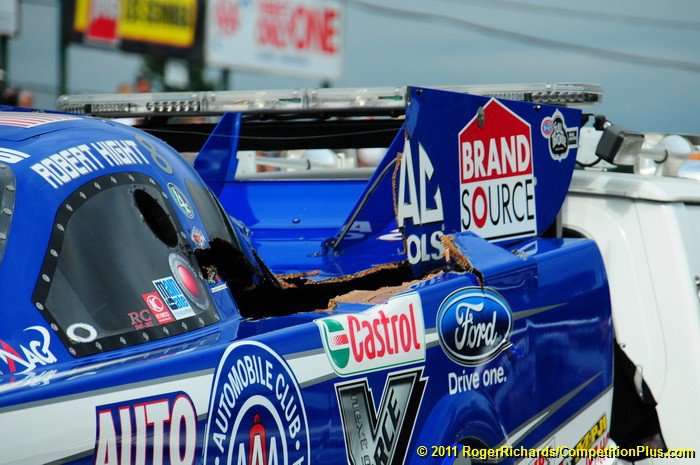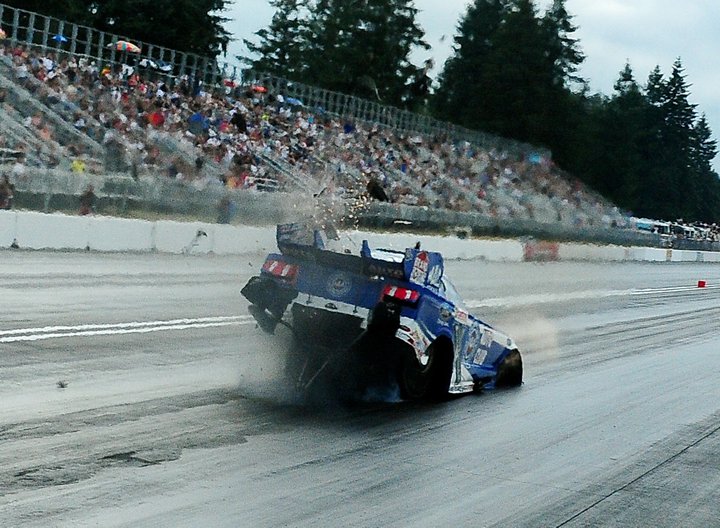'WE CAUSED IT OURSELVES,' HIGHT SAYS OF TIRE INCIDENT
 Neither Robert Hight nor Goodyear pointed fingers at the Pacific Raceways dragstrip surface for the August 5 incident in which the left rear tire of the Funny Car driver's Auto Club of Southern California Ford Mustang exploded just about 200 feet off the starting line.
Neither Robert Hight nor Goodyear pointed fingers at the Pacific Raceways dragstrip surface for the August 5 incident in which the left rear tire of the Funny Car driver's Auto Club of Southern California Ford Mustang exploded just about 200 feet off the starting line.
Hight said after seeing the tire company's carefully drawn conclusions he's certain that "that something punctured my tire leaving the starting line" and has decided that in all probability "we caused it ourselves."
Bryce Jones, Goodyear's sales account manager for drag tires, said, "Our researchers took all the parts and pieces and put them back together and put them on the wood buck, a wooden mold of what the tire should be. We take great pains to tell the NHRA that if we can, we want as many of the pieces back as possible. They collect all the parts and pieces and bring them to us. We got nearly every piece."
The Goodyear engineers, much like National Transportation Safety Board experts do after an airline crash, assemble the pieces on the buck -- "like a jigsaw puzzle," Goodyear Racing Public Relations Representative Lee Elder said.

Neither Robert Hight nor Goodyear pointed fingers at the Pacific Raceways dragstrip surface for the August 5 incident in which the left rear tire of the Funny Car driver's Auto Club of Southern California Ford Mustang exploded just about 200 feet off the  starting line.
starting line.
Hight said after seeing the tire company's carefully drawn conclusions he's certain that "that something punctured my tire leaving the starting line" and has decided that in all probability "we caused it ourselves."
Bryce Jones, Goodyear's sales account manager for drag tires, said, "Our researchers took all the parts and pieces and put them back together and put them on the wood buck, a wooden mold of what the tire should be. We take great pains to tell the NHRA that if we can, we want as many of the pieces back as possible. They collect all the parts and pieces and bring them to us. We got nearly every piece."
The Goodyear engineers, much like National Transportation Safety Board experts do after an airline crash, assemble the pieces on the buck -- "like a jigsaw puzzle," Goodyear Racing Public Relations Representative Lee Elder said.
Said Jones, "They put those parts and pieces under a microscope and they can tell quite a bit about the destructive cycle." In this case, he said, "they could look at the different cuts. They saw the one cut in the lower (inside) sidewall and could tell by the way the cords sheared that the tire was actually inflated when something entered the tire."
Hight, whose accident prompted the NHRA to tear up the starting-line area and repave it that Friday night, said, "I'm satisfied with Goodyear's explanation and report that they gave us about what happened to the tire. They pieced it all back together and showed us the witness marks and explained what they were talking about. It made 100-percent sense to me that something punctured my tire leaving the starting line. And it was going low [on air]. I pedaled it, and it blew it off there.
"I'm 100-percent convinced that Goodyear's right. What we'll never know is what punctured my tire. If I had to bet, in all honesty, and you just look at where it happened in the run and what could have gotten it, more than likely it was something off my car. We caused it ourselves."
He didn't reveal to CompetitionPlus.com or to Goodyear what he and his team decided that object might have been. But he explained why he concurred with Goodyear.
"It's easier to look at a blown-up tire than it is a blown-up race car and body, because that tire does so much damage after the fact that you can't tell," Hight said. "But when Goodyear shows us what happens to the tire when it all comes apart as a result of something else happening, you can see where the cords are pulled. It's torn. It's jagged. It's uneven. Then they show you where they believe the puncture came from, and it's a nice, smooth cut. It makes sense.
"So it's easier to look at a blown-up tire than it is a blown-up race car, because on a race car or even an engine that blows up, you look at all this aftermath and say, 'Was that a result of it blowing up?' or 'Was that the cause?' It's pretty hard to tell sometimes," he said.
John Force, Hight's boss and provisional No. 1 qualifier that day, said immediately after the incident, "If I thought it was the track . . . I had a man die and I crippled myself . . . If I thought it was totally the track's problem, then I wouldn't let my cars run. You think I want to go through that again? We could have run over something on the track. We could have had a tire go flat. We could have a body structure fly off and cut a tire. Sometimes you just don't know."
In the 2010 case of Courtney Force's tire explosion during her Top Alcohol Dragster pass also at Seattle, Hight said the team video clearly showed that she had run over an unidentified object on the track. Mark Niver, who died later that weekend in a race-day top-end accident, had run in the same lane immediately before she did.
Despite kudos all the way around for the NHRA officials who visually scour the track for wayward parts after each pass, the question lingers at this track and possibly others whether a rough racing surface can beat the race cars up so badly that more than the usual share of parts and fasteners and bolts fall off routinely.
Just the same, Hight said that in this case he couldn't blame the track itself: "I really don't believe so."
Elder said, "The tire could shake on any racetrack."
The Jimmy Prock-tuned team, with all its John Force Racing resources, didn't conduct its own independent investigation and match that against Goodyear's findings. Hight said his team accepted the tire company's findings that were based on the reconstruction of the damaged tire.
He said the conclusions everyone involved arrived at were "all Goodyear. It wasn't like we didn't look at everything very close. But still you can't look at it and say, 'This strut broke first' or 'Maybe the tire caused that strut to break.' Then maybe it wasn't anything off our car at all. Maybe there was something on the racetrack. NHRA does such a good job of looking at the racetrack that I tend to believe it was self-inflicted by something on our car.
"But it was also shaky," Hight said. "Maybe it wasn't broke previously. Maybe it broke on that run and punctured the tire and I pedaled it . . . Pretty tough to tell.
"We try to look at everything, because when something like this happens we've got to look at well, if something broke, we've got to make it stronger so it won't break again. If it broke once, it can break again," he said.
The complicated part is identifying that something.
"That's the trick," Hight said. "And we were not able to identify what could have come off first."
"Goodyear, I believe, deserves a lot of credit for really looking into it. Their main goal is to make us a better tire and constantly learn and get better, just like we do running race cars. We got to learn to make 'em quicker and faster and more durable and more consistent. They're on the same page as us with the construction of their tire."
Jones said, "Getting the car down the track is secondary to making sure the tires are safe. We try to make sure the tires are durable and can stand all the rigors that they go through out on the racetrack."
Force agreed. "Have you ever seen photos of when they run these tires? You ever see how hard you twist the tire and you tear the rubber out of it, trying to make it go down that racetrack? We abuse 'em, and I'm amazed they run as good as they do," he said that August day.
What seemed so shocking to the fans was that the explosion occurred right at the start of Hight's run on the 1,000-foot course, long before Hight was up to speed. But Jones and Elder said the tires of the nitro-powered cars bear a tremendous pressure for the outset of a run.
"There's still 7,000 horsepower going into that tire, even though it’s not going that fast," Jones said.
Said Elder, "The car's not going that fast, but the tire's spinning like crazy. The pressure that that tire is under right at the hit [of the throttle], it spins. Just because the car is just running a very short distance, it’s still under a great deal of pressure.
"The pressure -- not the air pressure inside the tire but the pressure on that tire to perform -- is still the same as it is at the far end of the track at 300 miles an hour. There's still a lot of forces working on that tire," Elder said.
"Remember -- the wheel spins at the very hit. The wheel spins, the tire doesn't, that first eight-millionth of a second. So just because the car's going only this far," he said, holding his hands to indicate a short spurt, "a lot of forces are going on out there. There's still a fantastic amount of force at work."
Jones likened the tires to a slingshot. "At the top of the track, he said, "the tire is stretched out because of speed. At the bottom end, it's wrapped up, wrapped up like a rubber band. The tire just acts like a rubber band. At mid-track, it's still wrapped up, trying to slingshot the car. So all that energy wrapping up the tire, if the tire's compromised, there's a good chance it could come apart."
It's a matter of physics, not engineering -- an absolute, not a manufactured function.
The tire came apart for Hight at Seattle. The root cause remains a mystery. But one thing is certain: Hight isn't blaming the racing surface.






































